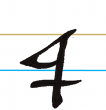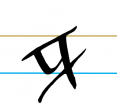Tionscadal na Nod
ar (q with stroke through descender)
Image:
1.

2.

1.
Source: Dublin, Trinity College, MS 1339 (H 2. 18, 1339) = Book of Leinster [s. xii2], p. 113bFile:
2.
Source: Dublin, Royal Irish Academy, MS D ii 1 (1225) = Leabhar Uí Mhaine (The Book of Uí Maine) [1394], f. 112raFile:
Letters displayed:
<q>
Base form in image, without marks, as it may appear to the untrained eye.
Represents in Irish:
ar
In the scribe’s mind or in normalised spelling.
Represents in Latin:
quia / quam / quod / qu()
In the scribe’s mind or in normalised spelling.
Unicode code point:
U+A757
Appearance
Build type:
Combination
Notational device:
Baseline symbol
Components:
At the baseline:
Alphabetic letters:
q (regular)
Represents: cu, cú (Irish)q (Latin)
Symbols:
cross stroke (subscript)
Represents: □(), □()r, (miscellaneous) (Irish)
Has allographs:
ar (allograph open)
Represents: ar (Irish)quia, quam, qu() (Latin)
Notational device: Subscript symbol, Allograph Allograph of: ar (q with stroke through descender)Meaning
Represents:
In Irish: ar
In Latin: quia / quam / quod / qu()
Comments:
The q with a stroke crossing its tail was originally used for Latin quia (‘because, for’) and also for quam and quod (occasional meanings include que and quid). The abbreviation was adopted in Irish writing to represent ar ‘for, seeing as’ (the Irish equivalent of quia), hence it came to stand for ar in general, both as a full word (especially as a preposition or conjunction) and as part of a word.
Type of unit:
Part of a word
Lexical item
Lexical class:
preposition
Context
Notational system:
Tironian notes
Frequency:
very common






















